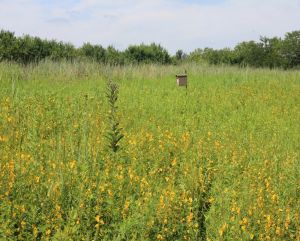
A study to experimentally assess impacts of neonicotinoid seed treatments on development and reproductive success among cavity-nesting solitary bee communities in Missouri agroecosystems.
Many of the more than 450 solitary bee species native to Missouri (e.g., leaf-cutter bees, longhorn bees) are important pollinators of both cultivated crops and native wildflower species. However, effects of seed treatment pesticides (neonicotinoids, fungicides) on these native bee communities are poorly understood. Most research in this area is conducted on eusocial honeybees and bumblebees, which represent only a small percentage of the total wild bee population. Native bees exhibit important life history traits that differ substantially from most eusocial species. Native bees are typically solitary, nest in the ground, or use soil or plant material to build nests in existing cavities. These traits may increase native bee susceptibility to pesticides due to more potential routes of exposure. With the exception of exposure to dust emission from pneumatic seeders during planting, estimates of bees’ exposure to pesticides generally are substantially lower than levels causing acute mortality. Yet, bee populations may still be negatively impacted by pesticide exposure through sub-lethal effects (e.g. reduced fecundity, skewed sex ratios). In Europe, neonicotinoid exposure in a controlled environment has been shown to reduce solitary bee reproductive success. However, demonstrating these effects outside a lab setting has proven more challenging. There is a particular lack of data linking the potential synergistic effects of pesticides and land management decisions in agroecosystems. Maintaining uncultivated land (e.g. hedgerows, woodlands, wildflowers) may buffer and/or protect pollinators against the potential sub-lethal effects of pesticide use, but this potential relationship remains poorly understood. It is important to understand whether landscape heterogeneity on Conservation Areas (CA) or conservation practices on cooperating private land acts as buffers or refugia for native pollinators. As global populations of invertebrates have declined significantly over the past few decades, and 65% of the land area of MO is encompassed in farms, there is a strong need to evaluate potential links between pesticides, land management decisions, and the decline of native bees in Missouri. These evaluations will provide important information for farmers, area managers, and policy makers trying to balance agricultural production against the long-term health of MO ecosystems. Objectives for this study include: 1) Assess impacts of seed treatment pesticides on development and reproductive success among cavity-nesting solitary bee communities in MO agroecosystems, 2) Explore routes of exposure and pesticide concentrations on private and public lands, and 3) Evaluate effectiveness of land management practices on CAs and cooperating private lands as buffers against the sub-lethal effects of agricultural pesticides including neonicotinoids and fungicides.
